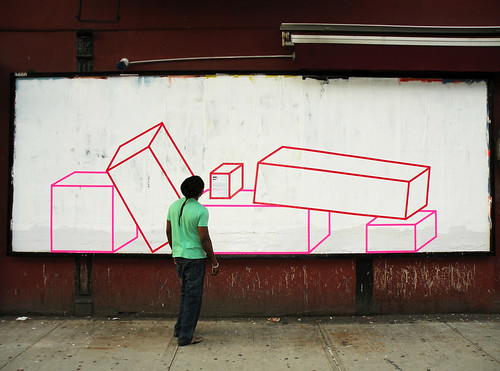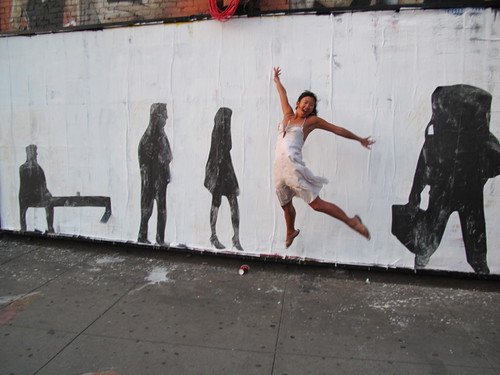Take Back the Street Picture: NYSAT
Photographs © NYSAT-Municipal Landscape Control Committee
Pictures are part of our modern landscape, and help create it, too. New York City tourists know they're here because their experience matches their image of it — an image formed often and substantially by pictures.
Paraphrasing Sontag: our streets are thickened by billboards, animated signs, and advertisements adhered to every surface, an irresistible mental pollution to which we are addicted, and we crowd along the avenues in an image-addled stupor, feeling that our citizenship is more stable than it is.
So...wow, that feels kind of negative.
But as you've heard me say in class, the best way to recognize their influence on us is to imagine a day without them, entirely off the grid, no pictures of any kind. I know this strikes a nerve somehow because I see you smile as I say it.
My friend Jordan knows the power of pictures, especially the advertising pictures that assault us on the sidewalk. His epic struggle against the visual cacophony spools out at Public Ad Campaign, where he links to the marketing industry's brazen encroachment into the public sphere. His latest effort, the New York Street Advertising Takeover, was an equally brazen counter-offensive designed to (temporarily) take it back.
Jordan writes:
On April 25th approximately 30 participants whitewashed nearly 120 street-level billboards in broad daylight between the hours of 10:30am and 2:00pm.Here's a video to plug you in:
At approximately 3:00pm nearly 50 artists and public individuals came back and used those blank canvases for the production of public messages instead of corporate messages.
Check the flickr page to see a couple hundred stills of the magnificent results.
Outrageous! Hugely successful! Not that many arrests!
But equally outrageous is that every one of the billboards that were whitewashed were illegal, or at least, not permitted by New York City. What?!
This map shows illegal/unpermitted NPA City Outdoor locations located in Lower Manhattan. All the ads together cover approximately 29,450 square feet of our public environment.

A full report with pictures and videos is posted on an interactive Google map available here.
Here's what I love about this project: an ad-hoc community of civic saviors steps up with old-fashioned paint buckets and rollers to shut down an out-of-control brat who's been pissing on our sidewalk for far too long. The technology of the offense is backed by corporate money that sees our streets as open range, free and clear for harvesting. But the technology of the defense - elbow grease and the modern tools of citizen participation, spurred on by some amazing organizational gumption - can match it. And for at least a few hours — i.e., until NPA/City Outdoor Advertising could regroup and put their ads back up — a bit of visual sobriety returned.
Here's something else that makes me hopeful: Jordan is a young guy with an old sense of responsibility. As an artist living an aesthetics of connection (something I want in my own life), he's idealistic in an age that sees idealism as inefficient or, worse, irrelevant. But maybe not - perhaps we're turning a corner on this idea.
On his mission:
Public Ad Campaign acts on the assumption that public space and the public's interaction with that space is a vital component of our city's health. By visually altering and physically interacting with the public environment, residents become psychologically invested in their community.On the NYSAT project, I asked him about the logistics. He told me he used a rented Zip car to scout every block of Manhattan south of 30th street:
Outdoor advertising is the primary obstacle to open public communications. By commodifying public space, outdoor advertising has monopolized the surfaces that shape our shared space. Private property laws protect the communications made by outdoor advertising while systematically preventing public usage of that space.
I approximated the size of each billboard because the posters they use are standardized in size. If I count 10 posters wide, the billboard is 20 ft wide. By doing this I could calculate the square footage — which was necessary because I had to have each whitewash team use a single 5 gallon bucket of paint. I wanted them to cover as much ad-space as possible without running out of paint, and not have much leftover. Since I knew the sizes of the ads and knew the bucket covered 1500 sq feet, I was able to break the map (of lower Manhattan) into 13 equal chunks (for 13 whitewash teams).When Jordan got in touch with me in March about NYSAT, I put some students in contact with him, but didn't act on it myself. Big mistake. I missed a monumental opportunity to engage something dear to me, namely, the visual health of the culture. This weekend he wrote again (with a link to the interactive Google map - awesome in itself), and I'm smiling like crazy.
The ads are illegal because they are un-permited. Out-door advertising must get permits through the city. This company never bothered and no one paid attention. It was a loophole. They would tell you they are legal, but the DOB would tell you they are illegal. I was hoping we would talk about it in court, but they didn't want to, for obvious reasons.
C'mon photographers, and picture-makers of every kind, we've got to take what we do more seriously - it isn't just screwing around, even if it is a good time.



Comments